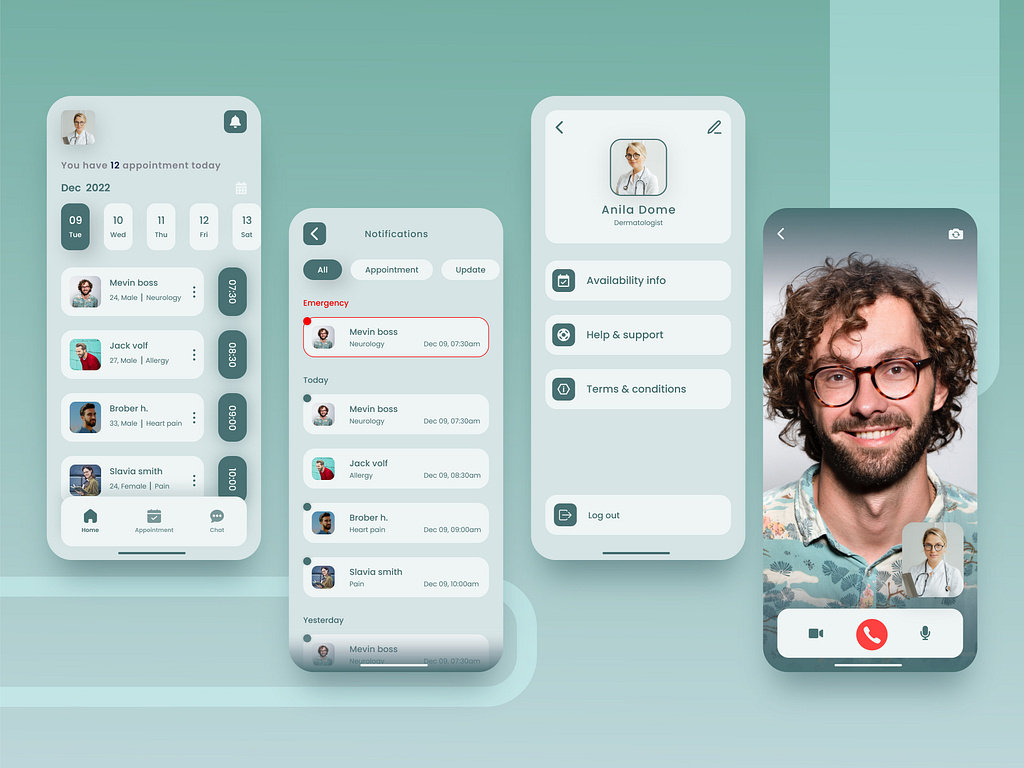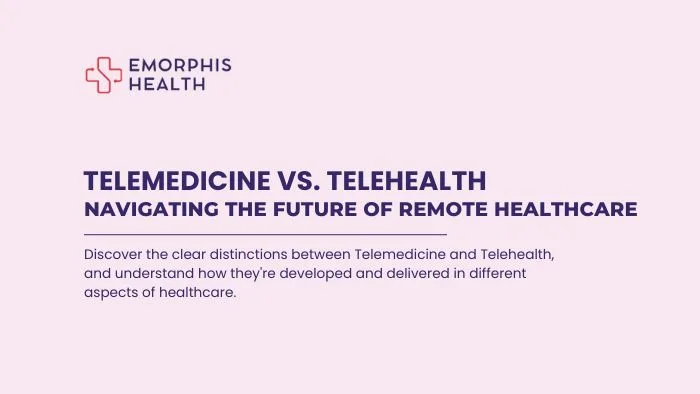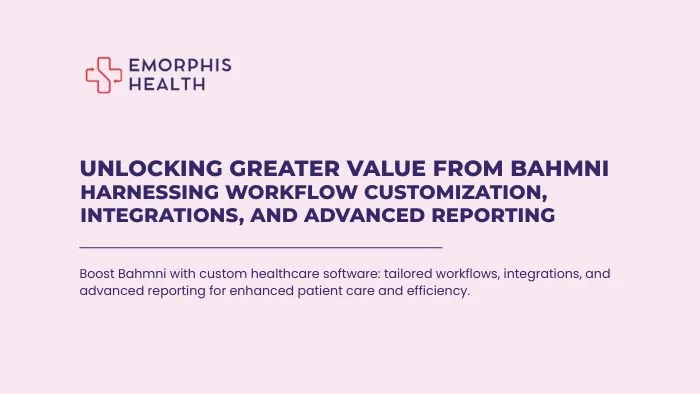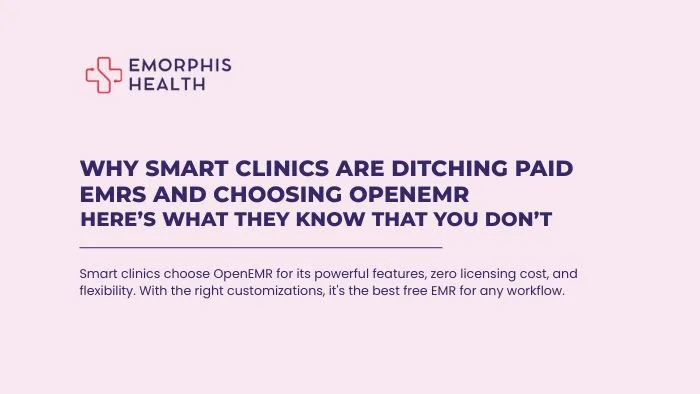In today’s healthcare world, where remote services are becoming increasingly common, distinguishing between the two terms, Telemedicine vs. Telehealth, can be confusing. People often mix up the words “Telemedicine” and “Telehealth.” but they represent distinct concepts with unique roles in healthcare delivery.
While telemedicine primarily focuses on remote clinical care, including virtual consultations and diagnosis, telehealth encompasses a broader spectrum of healthcare activities. This includes not only clinical services but also health education, administrative meetings, and remote patient monitoring initiatives. Understanding the nuances between telemedicine and telehealth is essential for navigating the evolving landscape of remote healthcare services and optimizing patient care.
Exploring Telemedicine
See Contents
- 1 Exploring Telemedicine
- 2 Definition of Telemedicine
- 3 Evolution of Telemedicine
- 4 Technological Infrastructure for Telemedicine
- 5 Popular Telemedicine Applications
- 6 Exploring Telehealth
- 7 Definition of Telehealth
- 8 Evolution of Telehealth
- 9 Technological Infrastructure for Telehealth
- 10 Popular Telehealth Applications
- 11 Telemedicine vs. Telehealth: Exploring the Key Differences
- 12 Telemedicine vs. Telehealth – in a table format
- 13 Future Outlook and Potential Directions
- 14 Conclusion – Leveraging the Strengths of Telemedicine vs. Telehealth
Telemedicine, a term gaining increasing prominence in healthcare discussions, refers to the provision of medical services remotely, using telecommunications technology. This innovative approach allows patients to consult with healthcare professionals without the need for in-person visits, breaking down geographical barriers and expanding access to care.
Definition of Telemedicine
Telemedicine encompasses a range of services, including virtual consultations, remote monitoring of patient’s health status, and even surgical procedures conducted by skilled professionals using robotic technology. Essentially, it enables healthcare delivery from a distance, leveraging various communication tools such as video conferencing, messaging platforms, and digital health monitoring devices.
Evolution of Telemedicine
The concept of telemedicine traces its roots back to the early 20th century when radio and telephone were first utilized for medical consultations. Over time, advancements in telecommunications technology, including the advent of the internet and digital imaging, propelled telemedicine into new frontiers. Today, it stands as a cornerstone of modern healthcare, offering innovative solutions to address the challenges of accessibility and efficiency.
Technological Infrastructure for Telemedicine
- High-Speed Internet Connectivity – A reliable internet connection is the lifeline of telemedicine. High-speed broadband ensures smooth audio and video transmission during virtual consultations, preventing lags or interruptions that could disrupt the patient-provider interaction.
- Secure Communication Platforms – Privacy and security are paramount in telemedicine. Healthcare providers must utilize encrypted communication platforms compliant with healthcare regulations (such as HIPAA in the United States) to safeguard patient data and maintain confidentiality.
- Telemedicine Software Platforms – Specialized telemedicine software is essential for scheduling appointments, conducting virtual visits, and managing electronic health records (EHRs). These platforms often feature user-friendly interfaces for both patients and providers, facilitating seamless interactions.
- Digital Diagnostic Tools – Healthcare providers may require access to digital diagnostic tools such as remote monitoring devices, digital stethoscopes, or portable ultrasound machines to perform comprehensive assessments remotely in certain telemedicine scenarios.


Popular Telemedicine Applications
1. Teladoc Health
Teladoc Health is one of the leading telemedicine platforms, offering virtual consultations with board-certified physicians via phone, video, or mobile app. Patients can access a wide range of medical services from the comfort of their homes, including urgent care, mental health support, and dermatology consultations.
2. Amwell
Amwell provides on-demand telemedicine services, connecting patients with licensed healthcare providers for non-emergency medical issues. The platform offers virtual visits for primary care, specialty care, and behavioral health, allowing patients to receive timely and convenient healthcare services without the need for in-person appointments.
3. MDLive
MDLive offers 24/7 access to board-certified doctors and therapists for virtual consultations via phone, video, or mobile app. Patients can receive medical advice, prescriptions, and treatment for a wide range of common health concerns, including cold and flu symptoms, allergies, and mental health conditions.
4. Doctor On Demand
Doctor On Demand provides video consultations with licensed physicians, psychologists, and psychiatrists for medical and mental health concerns. The platform offers comprehensive services, including primary care, urgent care, and behavioral health support, with convenient appointment scheduling and secure messaging features.
5. PlushCare
PlushCare offers telemedicine services for primary care, urgent care, and chronic disease management, connecting patients with experienced doctors for virtual consultations via phone or video. The platform focuses on providing personalized care and treatment plans tailored to each patient’s unique needs and preferences.
Exploring Telehealth
Telehealth, an increasingly vital aspect of modern healthcare, refers to the delivery of healthcare services and information remotely through telecommunication technologies. This innovative approach expands access to healthcare beyond traditional clinical settings, offering convenience and flexibility to patients and providers alike.
Definition of Telehealth
Telehealth encompasses a wide range of healthcare services delivered remotely, including virtual consultations, remote monitoring, health education, and administrative meetings among healthcare professionals. It leverages various communication tools such as video conferencing, mobile apps, and wearable devices to facilitate interactions between patients and providers, irrespective of geographical distances.
Evolution of Telehealth
The concept of telehealth has evolved significantly over the years, driven by advancements in technology and changing healthcare needs. Initially, telehealth focused primarily on providing healthcare services to individuals in remote or underserved areas. However, with the proliferation of digital communication tools and the increasing demand for convenient healthcare solutions, telehealth has expanded its scope to encompass a wide array of services, including chronic disease management, mental health support, and preventive care.
Technological Infrastructure for Telehealth
- Comprehensive Digital Health Platforms: Telehealth encompasses a broader range of healthcare services beyond clinical care. Therefore, the technological infrastructure must support comprehensive digital health platforms capable of accommodating various telehealth modalities, including remote patient monitoring, health education, and administrative meetings.
- Interoperable Electronic Health Record (EHR) Systems: Seamless data exchange is critical for coordinated care delivery in telehealth. Interoperable EHR systems allow healthcare providers to access patient records, share information securely, and maintain continuity of care across different telehealth modalities and settings.
- Wearable Devices and Remote Monitoring Solutions: Telehealth often involves remote patient monitoring to track vital signs, manage chronic conditions, and detect early warning signs of health deterioration. Wearable devices such as smartwatches, fitness trackers, and wireless sensors play a vital role in collecting real-time health data from patients in their everyday environments.
- Health Information Exchange (HIE) Networks: Collaboration and communication among healthcare providers are essential components of telehealth. Health Information Exchange (HIE) networks enable the seamless sharing of patient information, test results, and treatment plans among different healthcare organizations, ensuring continuity of care and informed decision-making.
Popular Telehealth Applications
1. Livongo
Livongo offers remote monitoring and coaching services for chronic conditions such as diabetes, hypertension, and behavioral health disorders. The platform provides connected devices, personalized insights, and 24/7 support to help patients manage their health and make informed decisions about their care.
2. Omada Health
Omada Health offers digital health programs for chronic disease prevention and management, focusing on lifestyle modifications and behavior change. The platform combines remote coaching, personalized care plans, and peer support to empower individuals to improve their health and well-being.
3. MyFitnessPal
MyFitnessPal is a popular telehealth app that helps users track their diet, exercise, and overall health goals. The app features a food diary, calorie counter, and personalized recommendations based on individual preferences and fitness objectives, making it easier for users to adopt healthier habits and achieve their wellness goals.
4. Calm
Calm is a meditation and mindfulness app that offers guided meditation sessions, sleep stories, and relaxation techniques to promote mental well-being. The app provides tools and resources for stress management, anxiety reduction, and better sleep quality, helping users cultivate a sense of peace and balance in their daily lives.
5. Fitbit
Fitbit is a wearable fitness tracker that monitors physical activity, heart rate, sleep patterns, and other health metrics. The device syncs with a mobile app to provide users with personalized insights, goal tracking, and motivation to stay active and healthy. Fitbit also offers community challenges and coaching programs to support users in achieving their fitness goals.


Telemedicine vs. Telehealth: Exploring the Key Differences
In the realm of modern healthcare, the terms “Telemedicine vs. Telehealth” are often used interchangeably, but they represent distinct concepts with unique roles in healthcare delivery. Understanding the differences between these two terms is crucial for grasping their contributions to the evolving healthcare landscape.
a. Defining Telemedicine vs. Telehealth
Telemedicine specifically refers to the remote delivery of healthcare services, including diagnosis, treatment, and monitoring, using telecommunications technology. On the other hand, telehealth is a broader term encompassing not only clinical services but also non-clinical activities such as health education, administrative meetings, and remote patient monitoring.
b. Scope and Applications of Telemedicine vs. Telehealth
Telemedicine primarily focuses on clinical care, enabling healthcare providers to conduct virtual consultations, diagnose illnesses, prescribe medications, and monitor patients’ health remotely. It encompasses various specialties, including primary care, mental health, dermatology, and radiology. Telehealth, on the other hand, extends beyond clinical care to address a wide range of healthcare needs, including health education programs, administrative meetings, and remote patient monitoring initiatives.
c. Technological Infrastructure Supporting Telemedicine vs. Telehealth
Both Telemedicine vs. Telehealth rely on robust technological infrastructure to facilitate remote communication, data exchange, and patient care. High-speed internet connectivity, secure communication platforms, and interoperable electronic health record systems are essential components of the technological backbone supporting telemedicine and telehealth initiatives. Additionally, specialized telemedicine software platforms and digital diagnostic tools are required to support clinical activities such as virtual consultations and remote monitoring.
d. Accessibility and Convenience in Telemedicine vs. Telehealth
One of the significant benefits of Telemedicine vs. Telehealth is improved accessibility and convenience for patients. By leveraging telecommunications technology, patients can access healthcare services from the comfort of their homes, eliminating the need for travel and reducing wait times. This convenience factor is especially beneficial for individuals with mobility issues, busy schedules, or living in remote or underserved areas.
e. Patient Outcomes and Satisfaction in Telemedicine vs. Telehealth
Numerous studies have demonstrated the positive impact of Telemedicine vs. Telehealth on patient outcomes and satisfaction. By providing timely access to healthcare services, facilitating continuity of care, and empowering patients to take an active role in managing their health, both Telemedicine and Telehealth contribute to improved health outcomes and higher levels of patient satisfaction.
f. Integration and Collaboration in Telemedicine vs. Telehealth
Telehealth plays a more inclusive role in integration and collaboration within the healthcare ecosystem by encompassing non-clinical activities such as health education and administrative meetings. Telehealth platforms facilitate seamless communication and collaboration among healthcare providers, enabling interdisciplinary care teams to work together effectively and improve care coordination.
Telemedicine vs. Telehealth – in a table format
Here’s the comparison between Telemedicine and Telehealth, highlighting differences across various aspects.
Aspect |
Telemedicine |
Telehealth |
| Definition | Remote delivery of clinical healthcare services, such as consultations, diagnosis, treatment, and monitoring, using telecommunications technology. | Remote delivery of a comprehensive range of healthcare services, including clinical care, health education, administrative meetings, and remote patient monitoring, facilitated through telecommunications technology. |
| Scope | Primarily focuses on clinical care delivery, including primary care, specialty consultations (e.g., dermatology, radiology), mental health services, and chronic disease management. | Encompasses a broader spectrum of healthcare activities beyond clinical care, such as health promotion, disease prevention, patient education, administrative meetings, and remote monitoring of patients’ health status. |
| Applications Features
|
Virtual consultations, diagnosis, and treatment of acute and chronic conditions, remote monitoring of vital signs, medication management, secure messaging, electronic prescribing, digital health records, and follow-up care. | Clinical care delivery, health education, and promotion, administrative meetings among healthcare professionals, remote patient monitoring programs, preventive care initiatives, and lifestyle management support. |
| Technological Infrastructure | Relies on high-speed internet connectivity, secure communication platforms (e.g., video conferencing software), telemedicine software platforms (e.g., EMR/EHR systems with telemedicine capabilities), and digital diagnostic tools (e.g., remote monitoring devices, digital stethoscopes). | Requires robust technological infrastructure, including high-speed internet, secure communication platforms compliant with healthcare regulations (e.g., HIPAA), interoperable electronic health record (EHR) systems, telehealth platforms (e.g., patient portals, mobile apps), and wearable devices (e.g., fitness trackers, remote monitoring sensors). |
| Accessibility and Convenience | Enhances access to specialized care for patients in remote or underserved areas, reduces travel time and costs associated with in-person visits, and offers convenience through flexible scheduling and virtual appointments. | Improves access to a wide range of healthcare services for patients with mobility limitations, geographical barriers, or busy schedules, providing convenient access to care from home or work environments. |
| Patient Outcomes and Satisfaction | Contributes to improved health outcomes by facilitating timely access to care, increasing patient compliance with treatment plans, and enabling proactive management of chronic conditions, leading to higher levels of patient satisfaction. | Enhances patient outcomes through comprehensive care delivery, including health education, lifestyle management support, and remote monitoring of health metrics, resulting in improved patient engagement and satisfaction with the healthcare experience. |
| Integration and Collaboration | Focuses primarily on clinical care delivery, with less emphasis on non-clinical activities, limiting collaboration to patient-provider interactions. | Integrates clinical and non-clinical services seamlessly, facilitating collaboration among multidisciplinary healthcare teams, including physicians, nurses, specialists, allied health professionals, educators, and administrators, to provide holistic care and support patient well-being. |
| Regulatory Compliance | Subject to specific regulations governing remote clinical services, such as licensing requirements for healthcare providers, privacy and security standards for telecommunication platforms, and reimbursement policies for telemedicine services. | Requires compliance with a broader range of regulations covering various aspects of healthcare delivery, including clinical care, health education, remote patient monitoring, and administrative functions, necessitating adherence to standards related to data privacy, patient consent, professional licensing, and healthcare reimbursement. |
| Cost Considerations | This can lead to cost savings for patients and healthcare organizations by reducing expenses associated with travel, facility overhead, and administrative overhead, as well as improving operational efficiency through optimized resource utilization and reduced wait times. | Offers potential cost savings by enhancing care coordination, reducing hospital readmissions and emergency room visits, and promoting preventive care measures, leading to lower overall healthcare costs and improved financial sustainability for healthcare systems and payers. |
| Impact on Healthcare Delivery | Facilitates the expansion of healthcare services beyond traditional care settings, enabling greater access to specialized expertise, reducing healthcare disparities, and improving patient outcomes, particularly for underserved populations and rural communities. | Drives the transformation of healthcare delivery by promoting patient-centered care models, fostering greater engagement and empowerment among patients, and leveraging technology to optimize care coordination, enhance communication, and improve healthcare outcomes across the continuum of care. |
| Quality of Care | Ensures remote delivery of accurate diagnoses, effective treatments, and adherence to clinical guidelines. | Facilitates comprehensive care delivery, including health education, preventive services, and remote monitoring, to improve health outcomes and patient satisfaction. |
| Patient Engagement | Promotes patient involvement in care decisions through interactive consultations, access to educational resources, and self-management tools. | Empowers patients with health knowledge, lifestyle management support, and tools for active participation in their care, fostering engagement and adherence to treatment plans. |
| Health Equity | Addresses healthcare disparities by improving access to care for underserved populations, minority communities, and rural areas through remote delivery of services. | Promotes health equity by ensuring access to a wide range of healthcare services and resources, regardless of geographical location, socioeconomic status, or other barriers. |
| Provider Experience | Enhances healthcare provider experience through streamlined workflows, efficient communication tools, and user-friendly interfaces for delivering remote care. | Supports healthcare providers with technology solutions that optimize workflows, facilitate collaboration, and enhance satisfaction with telehealth platforms. |
| Data Privacy and Security | Ensures compliance with regulations governing data privacy and security, such as HIPAA, to protect patient information during remote consultations and electronic health record (EHR) access. | Implements robust security measures to safeguard patient data, including encryption, access controls, and audit trails, to maintain privacy and confidentiality in telehealth interactions. |
| Scalability and Flexibility | Offers scalable solutions that can adapt to changing healthcare needs, accommodate varying patient volumes, and integrate with existing systems to support growth and expansion. | Provides flexible telehealth platforms capable of scaling to meet evolving demands, integrating with diverse healthcare environments, and accommodating customization based on specific requirements. |
| Patient Education and Empowerment | Provides educational resources, interactive tools, and personalized health information to empower patients with knowledge and skills for managing their health and making informed decisions. | Promotes patient education and empowerment through interactive content, self-management programs, and virtual support networks, empowering individuals to take an active role in their healthcare journey. |
| Cost of Development | Cost depends on project scope, complexity of features, compliance requirements, and integration needs. This may include software development, licensing, security measures, and ongoing maintenance.
Find details of the Cost of Developing a Telemedicine App. |
Development costs vary based on feature set, technology infrastructure, compliance, and scalability. Expenses may include software development, licensing, data security measures, and user training.
Find the details on the cost of telehealth app development. |
| Timeframe of Development | The development timeline ranges from a few months to a year or longer, depending on project complexity, regulatory approvals, and interoperability testing. | Similar to telemedicine, the timeframe varies based on project scope, feature complexity, and resource availability. Development may take several months to a year or more, considering compliance, integration, and user feedback. |
Future Outlook and Potential Directions
As we look ahead, the future of healthcare appears increasingly intertwined with the realms of Telemedicine vs. Telehealth. These innovative approaches have already revolutionized how we access and receive healthcare services, and their potential for further transformation is immense.
In the coming years, Telemedicine vs. Telehealth are poised to become even more integral components of the healthcare ecosystem. Advances in technology, coupled with evolving patient needs and healthcare delivery models, will drive innovation in Telemedicine vs. Telehealth, shaping their future trajectory.
One potential direction for Telemedicine vs. Telehealth is the expansion of their scope and capabilities. While both have already demonstrated their effectiveness in delivering clinical care remotely, there is room for growth in areas such as preventive care, chronic disease management, and mental health support. By broadening their focus to encompass holistic healthcare delivery, Telemedicine vs. Telehealth can address a wider range of patient needs and contribute to improved health outcomes.
Another area of opportunity lies in enhancing the integration and interoperability of Telemedicine vs. Telehealth platforms with existing healthcare systems. Seamless integration with electronic health records (EHRs), interoperability between different telehealth platforms, and data exchange standards will facilitate smoother workflows and better coordination of care across healthcare settings.
Additionally, Telemedicine vs. Telehealth have the potential to democratize access to healthcare on a global scale. By leveraging technology to overcome geographical barriers, reach underserved populations, and reduce healthcare disparities, Telemedicine vs. Telehealth can bring quality healthcare services to communities that have traditionally faced challenges in accessing care.
Further Research and Investment in Telemedicine and Telehealth
Given the promising outlook for Telemedicine vs. Telehealth, there is a pressing need for continued research and investment in these fields. As we embark on this journey toward a more connected and accessible healthcare system, here are some key areas where further research and investment can make a significant impact.
- Technology Innovation: Invest in research and development efforts to advance telemedicine and telehealth technologies, such as artificial intelligence (AI), machine learning, virtual reality (VR), and remote monitoring devices. These technologies have the potential to enhance diagnostic accuracy, personalize treatment plans, and improve patient engagement.
- Regulatory Frameworks: Advocate for policies and regulations that support the widespread adoption and integration of Telemedicine vs. Telehealth into mainstream healthcare delivery. Streamlined licensure requirements, reimbursement policies, and telehealth parity laws can incentivize healthcare providers to embrace Telemedicine vs. Telehealth and ensure equitable access to care for all patients.
- Evidence-Based Practices: Conduct rigorous research studies to evaluate the effectiveness, cost-effectiveness, and long-term outcomes of Telemedicine vs. Telehealth interventions across different clinical specialties and patient populations. Evidence-based practices will guide healthcare organizations in implementing Telemedicine vs. Telehealth solutions that deliver optimal value and quality of care.
- Workforce Training: Invest in training programs and educational initiatives to prepare healthcare professionals for the digital healthcare landscape. Equip clinicians with the skills and knowledge needed to effectively leverage Telemedicine vs. Telehealth technologies, communicate with patients remotely, and deliver high-quality care in virtual settings.
- Infrastructure Development: Build robust telecommunication infrastructure, particularly in rural and underserved areas, to ensure reliable connectivity and access to Telemedicine vs. Telehealth services. Expand broadband internet access, invest in telecommunication networks, and deploy telehealth hubs in community centers to bridge the digital divide and reach marginalized populations.
Conclusion – Leveraging the Strengths of Telemedicine vs. Telehealth
In conclusion, Telemedicine vs. Telehealth offers distinct but complementary approaches to healthcare delivery. While telemedicine focuses specifically on clinical care, providing remote diagnosis and treatment services, telehealth encompasses a broader range of healthcare activities, including non-clinical services and administrative functions.
By understanding the differences and leveraging the strengths of Telemedicine vs. Telehealth, healthcare organizations can enhance access to care, improve patient outcomes, and drive efficiency in healthcare delivery.
The future of healthcare is bright with the promise of Telemedicine vs. Telehealth. By investing in research, innovation, and infrastructure development, we can harness the transformative power of Telemedicine vs. Telehealth to create a more accessible, equitable, and patient-centered healthcare system for all.
Let us seize this opportunity to shape the future of healthcare and improve the lives of individuals and communities around the world.
Looking to delve deeper into the realm of healthcare software and app development?
Look no further than Emorphis Health. With a team of seasoned experts specializing in healthcare technology, Emorphis Health is your trusted partner in bringing innovative solutions to life. Whether you’re seeking to enhance patient care, streamline clinical workflows, or revolutionize healthcare delivery, our team has the expertise and experience to turn your vision into reality.
Connect with us today to unlock the full potential of healthcare software and app development and embark on a journey toward transformative healthcare solutions.









